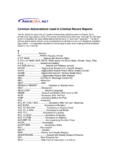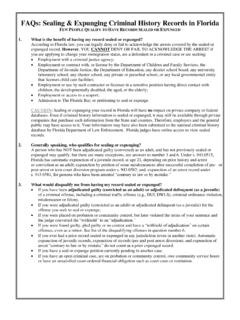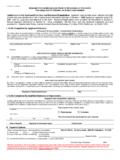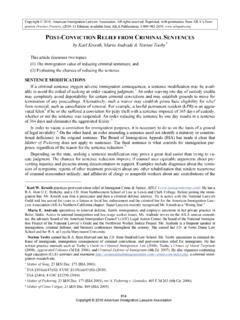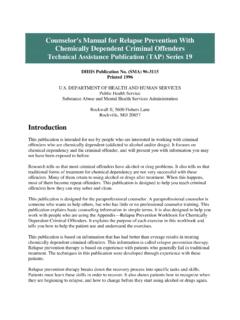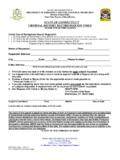Transcription of Criminal and Addictive Thinking - Indiana Criminal …
1 10/1/20131 Criminal and Addictive Criminal and Addictive ThinkingThinkingThinkingThinkingA cognitiveA cognitive--behavioral therapy approachbehavioral therapy approachPresenter: Phillip BarbourPresenter: Phillip BarbourGoals of Criminal Thinking Therapy To describe and provide examples of common Criminal Thinking errors in the offender pop lationpopulation. To help mental health and corrections practitioners and offenders become more aware of Thinking errors and Thinking distortions. To assist change agents in facilitating the Criminal Thinking change Criminal Thinking scope is wideThe Criminal Thinking scope is wide The module was created with community based The module was created with community based programming in in mind.
2 Individual study or openIndividual study or open ended groupsended groups A group size of 8 to 12 participants is suggested, A group size of 8 to 12 participants is suggested, but larger groups are effective toobut larger groups are effective too The module is designed to be used in The module is designed to be used in collaboration with the Criminal Thinking Errors collaboration with the Criminal Thinking Errors WorksheetsWorksheets10/1/20132 Criminal Thinking works in other programs Corrective Thinking , Domestic Violence, AODA and/or Cognitive Behavioral focus Adult male or female offenders Batterers and/or drug abusers 7th grade reading level is the intended target audienceThe History Utilizes the theory and principles developed by Stanton Samenow and Yochelson InvestigationofCriminalBehavioratStEliza beths Investigation of Criminal Behavior at St.
3 ElizabethsHospital in Washington, The longest clinical research of offenders in North America Three volume publication The Criminal Personality(Lanham, Md.: Roman and Littlefield) that he co authored with Dr. Yochelson. Question: What is Criminal Thinking ? Thinking ?A simple question10/1/20133 Thinking that says that its l i ht ti l tththalright to violate others or the property of others Samuel Yochelson and Stanton SamenowWhy talk about Criminal Thinking ? Broaden the scope of intervention Provide information to help your clients To help identify persons where this may be an issue. To aid the Criminal thinker in developing, expanding and sustaining a moral List: Errors in ThinkingThe List: Errors in Thinking1.
4 Closed Channel Thinking6. Lack Of Interest In Responsible Performance2. Victim Stance3. Views Self As A Good Person4. Lack Of Effort5. Fear Of FearPerformance7. Lack Of Time Perspective8. Power Thrust9. Uniqueness10. Ownership AttitudeCitation: Closed Channel Thinking Not Receptive Not Self Critical No Disclosure Good at pointing out, giving feedback on faults of others Lies by omissionCitation: Victim Stance Views self as victim (the Criminal will even blame social conditions I live in the ghetto, what do oe pect )you expect ) Blames others ( the cops just keep messing with me )Citation: Views Self As A Good Person Focuses only on his/her positive attributes Fails to acknowledge his/her destructive behavior Builds self up at others expenseCitation.
5 Lack Of Effort / Selective Effort Unwilling to do anything he/she finds boring or disagreeable "I can't" meaning "I won't Doing only the minimum to get byCitation: Lack Of Interest In Responsible Performance Responsible living viewed as unexciting and unsatisfying No sense of obligation Will respond only if he/she nets an immediate payoff6. Lack Of Time Perspective Does not use past as a learning tool Expects others to act immediately on //his/her/demands Decisions on assumptions, not facts10/1/201367. Fear Of Fear Irrational fears (many) but refuses to admit them Fundamental fear of injury or death Profound fear of put down When held accountable experiences "zero state feels worthless8.
6 Power Thrust Compelling need to be in control of every situation Uses manipulation and deceit Refuses to be dependant unless he/she can take advantage of the situation9. Uniqueness Different and better than others Expects of others that which he/she fails to meet Super Optimisim cuts fear of failure Quits at the first sign of failure10/1/2013710. Ownership Attitude Perceives all things, people, objects to possess No concept of ownership, rights of others Sex for power and control not intimacy Use drugs/money as a means of controlling peopleHow do you know?yWhat are some tactics used by the Criminal thinker?
7 Criminal Thinking Tactics1. Continuously point out staff inadequacies2. Building self up by putting others others what they want to hear4. Lying, distorting the truth5. Vagueness6. Diverts attention7. Putting others on the defensive8. Total inattention9. Accusing others of misunderstanding10/1/20138 Criminal Thinking Tactics to confuse the without meaning a big scene about minor off doing something by saying I that they have changed because they did something right, once!Factor s of people s past that contribute to Criminal conduct A history of early involvement in deviant or antisocial and Criminal conduct; Havinggrownupinadisruptiveabusiveand Having grown up in a disruptive, abusive and neglectful family where there was lack of parental attention and supervision; Failure in school, work and leisure time.
8 AOD disorders at an early ageRisk factors contributing to Criminal conduct Criminogenic need: Dynamic risk factors or attributes of offenders that, when changed, infl encetheprobabilitofrecidi isminfluence the probability of recidivism 10/1/20139Do criminals think differently than normal people? Researchers believe thought patters are more important than biology or environmentindeterminingwhobecomesaenvir onment in determining who becomes a Criminal . Some major characteristics include: master manipulators compulsive liars people not in control of their own errors or Thinking distortions A cognitive distortion is a way of Thinking that is automatic to the point that we continue to engage in the errors of Thinking even though our experiences and the facts do not support the Thinking errors.
9 The mental process required by the Criminal to live his/her kind of Criminogenic Need Principle Most offenders have many needs. However, certain needs are directly linked to crime. Criminogenicneedsconstit tednamicriskfactorsorneeds constitute dynamic risk factors or attributes of offenders that, when changed, influence the probability of recidivism. 10/1/201310 Criminogenic Needs: Self oriented communication patterns Need for family closeness and communication Needforprimarysocialunitstructuressuchas family Need for primary social unit structures such as family Involvement in antisocial and deviant behaviors Need to manipulate and to control others Receive rewards through Criminal conduct Participate in environments of high risk for Criminal conductCriminogenic Needs: continued Blame others for own action and behaviors Impaired moral reasoning.
10 Hold self serving/antisocial moral codes Overall impaired social and interpersonal skills Overt acting out of feelings of anger and resentment Thinking in a black and white concrete manner Need to use substances to support Criminal and antisocial conductQuestion: Who are they really hurting?hurting? Injuries Unseen10/1/201311 Injury worksheetSelf & VictimFamiliesNeighborsCommunityQuality of Life Ripple Effect How do you fix this?yRelated Self-correctionsCriminal Thinking Scales Entitlement Justification Personal Irresponsibility Power Orientation Cold Heartedness Criminal Rationalization Knight, K., Simpson, D.
